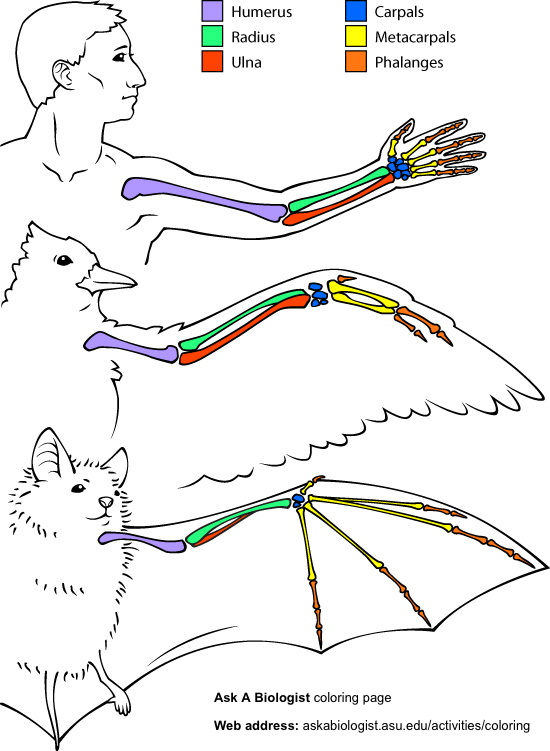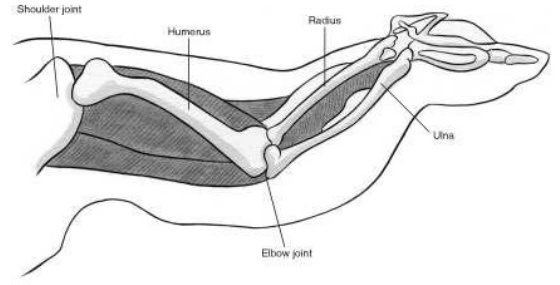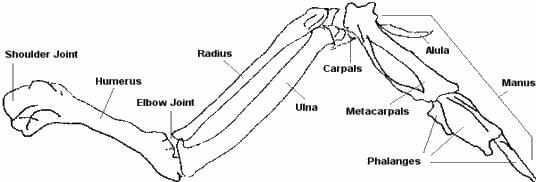Chicken Wing Dissection
The vertebrate forelimb of human, bird, and bat may not appear to have much in common, but a closer examination of the anatomy shows that the same bones were applied to a variety of different jobs in each of these species. Evolution doesn't plan ahead. It can only work with what's available. The color coding shows the way the bony elements were modified in each species. You might think that the two wings would be more similar in design because of the job they do but, in fact, the bird wing and human arm are more similar on the interior. However, the bird "hand" is reduced, whereas the bat and human hand have more in common. See if you can find a similar image of a dolphin or whale flipper for another comparison. What predictions can you make before seeing the internal anatomy?

Vertebrate Forelimb Anatomy
Review the following terms in Wikipedia:
Chicken Wing Anatomy: Watch the following video as a general guide to the procedure.
Safety precautions:
- Since you will be handling raw chicken, which may have germs on the surface, please wash your hands with soap and water before and after this procedure.
- You may use rubber gloves if desired, or bare hands if you prefer.
- To reduce the chance of jabbing or cutting yourself, the only tools you will need are scissors and tweezers.
- Wash all equipment in hot soapy water when done.
- Discard the chicken wing and parts at the end of this exercise.
Examine the intact wing
- Holding the wing at the shoulder and wing tip, fully extend the wing.
- Note the locations of the joints where the wing bends.
- Note the directions in which the joints bend.
- Use your fingers to feel the bones and muscle bundles beneath the skin.
- Note the locations where the feathers were inserted into the skin.

Chicken wing with skin and muscle attached
Remove only the skin
- Using the scissors, remove as much of the skin as you can, cutting along the line of the bones.
- Be careful not to cut the muscles, ligaments, and tendons.
- Blot dry any fat with a paper towel, and remove it to expose the underlying anatomy.
- "Manus" is derived from the same word root as "manual." What is the equivalent part on your body?
- The elbow joint is labelled in this figure. Where is the wrist joint?
- The "alula" is the equivalent of what part of your hand?

Bones of the chicken wing
Examine the soft tissues
- Locate the two muscle bundles that bend and straighten the lower section of the wing, below the elbow joint, by pulling on each muscle in turn.
- Note that these muscles are in opposition to each other. When one tightens, the other lengthens.
- Note the points at which these muscles attach to the bone, and carefully remove them one by one.
- Can you find the cartilage at the joint between the humerus and radius/ulna?
- Did you notice that the muscles that move the lower wing are in the upper wing? Where are the muscles that control the upper wing in the chicken?
- Can you find the ligaments that hold the bones together?
- Bend your arm at the elbow and hold it tight. Notice that your bicep muscle shortens. Now, extend your arm, and feel your bicep lengthen.
- Look at your hand. Where are the muscles that move your fingers? Hint: Press on your wrist and forearm while wiggling your fingers.
- Why is the thumb so important for gripping objects? Try to pick something up without using your thumb.
- Raise and lower a heavy object like a textbook while bending your arm at the elbow. Have a partner feel which muscles are acting during raising and lowering.
Review Questions:
- What is the difference between a ligament and a tendon?
- What is the difference between flexion and extension?
- What is the difference between adduction and abduction?
- What does it mean when we say that muscles are in opposition?
- Does a muscle perform an action when it is contracting or relaxing?
- What is the purpose of the cartilege?
- Research the various types of joints. Describe three or more types, including the range of motion that each allows.
- What does it mean that the human thumb is opposable? What is it opposed to?
- Research the anterior cruciate ligament, or ACL. Why is it commonly damaged in football and skiing injuries?
- Research the achilles tendon. What is the purpose of tendons? What do the tendons in your hand do?
Extra Credit:
- Using rubber bands or bungee cords as muscles and popsicle sticks as bones, with duct tape or hinges as joints, or with other appropriate materials, make a working model of the human arm or hand.

